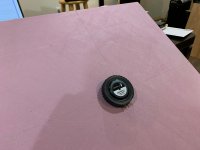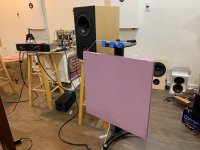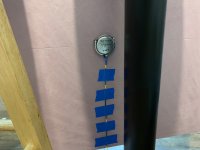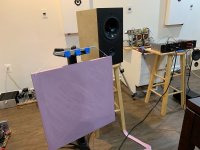Interesting finding. As far as I can gather the Golden Ratio is mainly used for panel dimensions. Exciter placements used are mostly the 2/5 3/5 distance rule, or the Monacor placements. However, I recall in the TI video they used the 2/5 placement rule in one panel and a dead center placement in the other panel for a stereo pair.I see many people talk about the Golden ratio and this is the technique I deviate from based off my own (ears) personal preference and certain principles.
My exciter placement is close to and or dab smack in the middle of the panel. I've tried the so called golden ratio and to my ears it don't sound right.
When placed in the middle it has the "BEST" midrange out put and coherency as well as the best bass and over all balance.
Interesting finding. As far as I can gather the Golden Ratio is mainly used for panel dimensions. Exciter placements used are mostly the 2/5 3/5 distance rule, or the Monacor placements. However, I recall in the TI video they used the 2/5 placement rule in one panel and a dead center placement in the other panel for a stereo pair.
OH my bad not panel dimensions but the 2/5 3/5 or monacor placements golden rule.
If I want to use the 24in x 24in panels as is, how bad would that be vs cutting it to form a non symmetric rectangle or trapezoid, I wonder. Should exciter be 2/5 in one direction and 3/5in another even on square panel? What is one cuts a hole at said 2/5 and 3/5 to put asymmetry into the panel and mounts exciter at opposite 2/5 and 3/5 or in center?
All these things are doable with a FEM model simulation. Someone should do that.
All these things are doable with a FEM model simulation. Someone should do that.
Veleric posted a nice method for locating the best position for an exciter in post #645.
To paraphrase you lay the panel horizontally on supports, play music through the exciters and try different positions on the panel you are testing by holding to exciter to the panel. Great technique, simple, immediate feedback and easily repeatable
To paraphrase you lay the panel horizontally on supports, play music through the exciters and try different positions on the panel you are testing by holding to exciter to the panel. Great technique, simple, immediate feedback and easily repeatable
Veleric posted a nice method for locating the best position for an exciter in post #645.
To paraphrase you lay the panel horizontally on supports, play music through the exciters and try different positions on the panel you are testing by holding to exciter to the panel. Great technique, simple, immediate feedback and easily repeatable
Haha, funny thing is I just reread that post and realized that I did not explicitly say that I used that technique to study the effect of exciter position. But your inference was correct, that is indeed exactly what I do.
Interestingly, my overall impression is that exciter position actually makes less difference than I initially expected. Typically I have done this experiment while playing pink noise and monitoring the output with an RTA app on my phone. I know/admit that this is a pretty crude measurement and I suspect that if I performed proper REW sine sweep measurements instead I would probably see a lot more difference between exciter locations than I do with my simple pink noise RTA test. Someday I'll do that.
I have observed that having the exciter in the vicinity of the center gives more output. But otherwise, I don't see any clear trends. Supposedly, the exact center (or anywhere along either center line) is a generally cited as a poor location, because so many modes have nodes there, and hence you minimize the number of modes you can potentially drive. My "measurements" however haven't shown any significant difference between the exact center and other locations nearby.
Likewise, the 3/5 location doesn't appear to me to be particularly magical. Is seems to give about the same result as about anywhere in the general vicinity of the center.
Eric
Interesting Eric! I am beginning to think that DML’s are very ‘tolerant’ of design hacks. You have to try really hard to get a bad sound. No doubt the academic studies done have to be very rigorous so small differences matter, but for DIY PhD level accuracy isn’t really required.
If I want to use the 24in x 24in panels as is, how bad would that be vs cutting it to form a non symmetric rectangle or trapezoid, I wonder. Should exciter be 2/5 in one direction and 3/5in another even on square panel? What is one cuts a hole at said 2/5 and 3/5 to put asymmetry into the panel and mounts exciter at opposite 2/5 and 3/5 or in center?
All these things are doable with a FEM model simulation. Someone should do that.
I actually have been doing a lot of FEM simulations lately. In fact, since you started writing about other shapes, just yesterday I modeled an irregular quadrilateral to see how it varied from a square or rectangle.
What I found is that it doesn't make change the overall distribution of modes much. Compared to a square (or nearly square) panel, the irregular panel has a similar fundamental resonant frequency, and a similar density of resonant modes at increasing frequency. What does change a lot is the mode shapes corresponding to the resonant frequencies. As you might expect, the mode shapes for square and rectangular panels are very symmetric and regular, like the dimples on the surface of egg crate foam, but for the irregular quadrilateral the modes shapes are themselves very asymmetric and irregular.
Now, does that make a difference in how it sounds? Unfortunately, that I do not know. My suspicion is that it makes some difference (everything does), but not much...
Eric
Interesting Eric! I am beginning to think that DML’s are very ‘tolerant’ of design hacks. You have to try really hard to get a bad sound. No doubt the academic studies done have to be very rigorous so small differences matter, but for DIY PhD level accuracy isn’t really required.
I agree, but I have to admit I'm kinda disappointed by that. I'm an engineer (just MS, not PhD) with some (limited) experience in vibrations and sound. I assumed that my background knowledge and experience would help me build something better than your average hack. Now I'm not so sure...
Eric
If I want to use the 24in x 24in panels as is, how bad would that be vs cutting it to form a non symmetric rectangle or trapezoid, I wonder.
Not that bad I think, but it depends a little on what your panels are.
The purpose of using rectangular instead square panels is to increase the number of unique modes/frequencies of vibration. But if the panel material you are using is anisotropic (i.e. bends easier in one direction than the other), then a square panel will likely accomplish the same thing.
If you are pretty sure your panel is isotropic (same in both directions), it probably wouldn't hurt to cut a bit off one edge. Go for the 1.13 ratio.
But if your panel is already anisotropic, cutting it will just as likely make it worse as better. Might as well leave it alone in that case, especially if you have some reason to prefer not to cut it.
Eric
I'm an engineer (just MS, not PhD) with some (limited) experience in vibrations and sound. I assumed that my background knowledge and experience would help me build something better than your average hack.
Eric
That’s good to know Eric. I think there is still a lot to explore but more in materials and exciter design but I am too busy listening at the moment 🙂. I certainly want to explore more on the materials front and there are some issues with two of the exciter designs I have used to date.
Burnt
Veleric,
The polycarbonate I used is sold as glazing polycarbonate, used for pergolas and green houses I believe. It is internally 'ribbed' and 4mm thick. It is lightweight and quite rigid, especially across the ribs. I have designed them using the Golden Ratio of Nature 1.618, as I was unaware at the time of the Golden Ratios for DML panels. They are untreated.
gapmedia,
Thanks. That looks and sounds like interesting stuff. I just put in an order at Lowes for some, but it's thicker stuff, closer to 8 mm. I'm thinking the 4 mm is probably better in some respects but I could not find a local source for a small quantity of the 4 mm so went ahead and ordered the thicker. I'll have it in about a week they say.
Eric
Sorry, I wish I could work out how to use quotes in this forum to reference my replies. I'm sure the instructions are somewhere.😕
Eric,
The 4mm stuff I purchased is no longer produced by the manufacturer here in Australia. Seems 6, 8, 10+ stuff is more common. I did see larger sheets of 4mm but at twice the price I paid for mine, not that it was expensive.
Will be interested to see what you think of the polycarbonate, as I haven't tried much alse as a diaphram yet. I haven't tried it, but it should be fairly easy to play with damping of the polycarbonate by running wool or similar down various channels in the board. I do have a blob of blu-tack positioned on the front of the panels over the exciter, which I found in REW to smooth the frequency responce around 3khz or so, I think.
Also, I did do some exciter placement testing with REW about 2 years ago, when I first started to play with a pair of small Dayton exciters. I tested the placement of one exciter through 30 or so positions on a grid drawn in a quadrant of the (bamboo laser ply) diaphram. Surprisingly or not, from memory, the best frequency responce was achieved with the exciter pretty much at the suggested 2/5 position. Can't recall if there were great variations in volume between placement positions. Will see if I can find the old graphs somewhere to check.
I believe that NXT had a software package available to design and model diaphram design if you licensed their technology, but I don't know what ever happened to it after NXT's demise. Have never been able to find a stray copy on the net.
Eric,
The 4mm stuff I purchased is no longer produced by the manufacturer here in Australia. Seems 6, 8, 10+ stuff is more common. I did see larger sheets of 4mm but at twice the price I paid for mine, not that it was expensive.
Will be interested to see what you think of the polycarbonate, as I haven't tried much alse as a diaphram yet. I haven't tried it, but it should be fairly easy to play with damping of the polycarbonate by running wool or similar down various channels in the board. I do have a blob of blu-tack positioned on the front of the panels over the exciter, which I found in REW to smooth the frequency responce around 3khz or so, I think.
Also, I did do some exciter placement testing with REW about 2 years ago, when I first started to play with a pair of small Dayton exciters. I tested the placement of one exciter through 30 or so positions on a grid drawn in a quadrant of the (bamboo laser ply) diaphram. Surprisingly or not, from memory, the best frequency responce was achieved with the exciter pretty much at the suggested 2/5 position. Can't recall if there were great variations in volume between placement positions. Will see if I can find the old graphs somewhere to check.
I believe that NXT had a software package available to design and model diaphram design if you licensed their technology, but I don't know what ever happened to it after NXT's demise. Have never been able to find a stray copy on the net.
Last edited:
I built a simple DML using square 1in thick 24x24in XPS panels. I sanded the surfaces with 100 grit sandpaper. I treated one of them with 30:70 PVA:water and was going to see if I could measure any differences between treated and untreated. Tapping them with my hand and listening to the sound and resonance, I cold not hear the difference it made. I ended up suspending them from string onto an aluminum crossbar that allowed them to be suspended from a 30in tall speaker stand. After installing the stereo pair I was disappointed to find out that the left channel exciter went dead upon using it for 1 minute. A check with an ohm meter showed open circuit (pretty dissappointing quality control on the Dayton DAEX32U-4 driver). Really wanting to hear stereo - I removed the bad Dayton and installed a Tectonic TEAX32C30-4/B driver. Different exciters on left and right channel I know but this will have to do until I get a replacement Dayton. The sensitivity sounds about the same with both so not too far off. Listening to it, definitely sounded way too bright - and unbalanced - like it needed a BSC shelf. So I went in Jriver DSP and added a -6dB Q=0.5 high shelf at 1kHz for the BSC. I also added +3dB Q=0.6 200Hz low shelf to boost some bass back. Sound is much more balanced now. Driving with VHEX+ 100w Class AB driven by AK4490 DAC from my Cayin N3 via USB 3.0 from PC laptop running Jriver flac or wav files. The sound is surprisingly good considering how simple and inexpensive the speakers are. The sound is wide and lacks pinpoint imaging. But for most music, it works. I am not wowed by it though. Maybe using identical exciters on left and right might make a difference - we will see.
Listening to jazz with Chick Correa, Dave Brubeck, Melody Gardot; also some pop and classic rock thrown in. With the EQ, much better and could be really good with a sub woofer.
Applying PVA water mixture. I used a hair dryer to speed up drying.

Dayton DAEX32U-4 (good one) mounted at 2/5 (10in) and 3/5 (14.4in) from edge for 24in x 24in panel. I used soft 28ga wire taped to the panel to bring the leads from the exciter to my amin banana plug speaker cables using female bullet connectors.
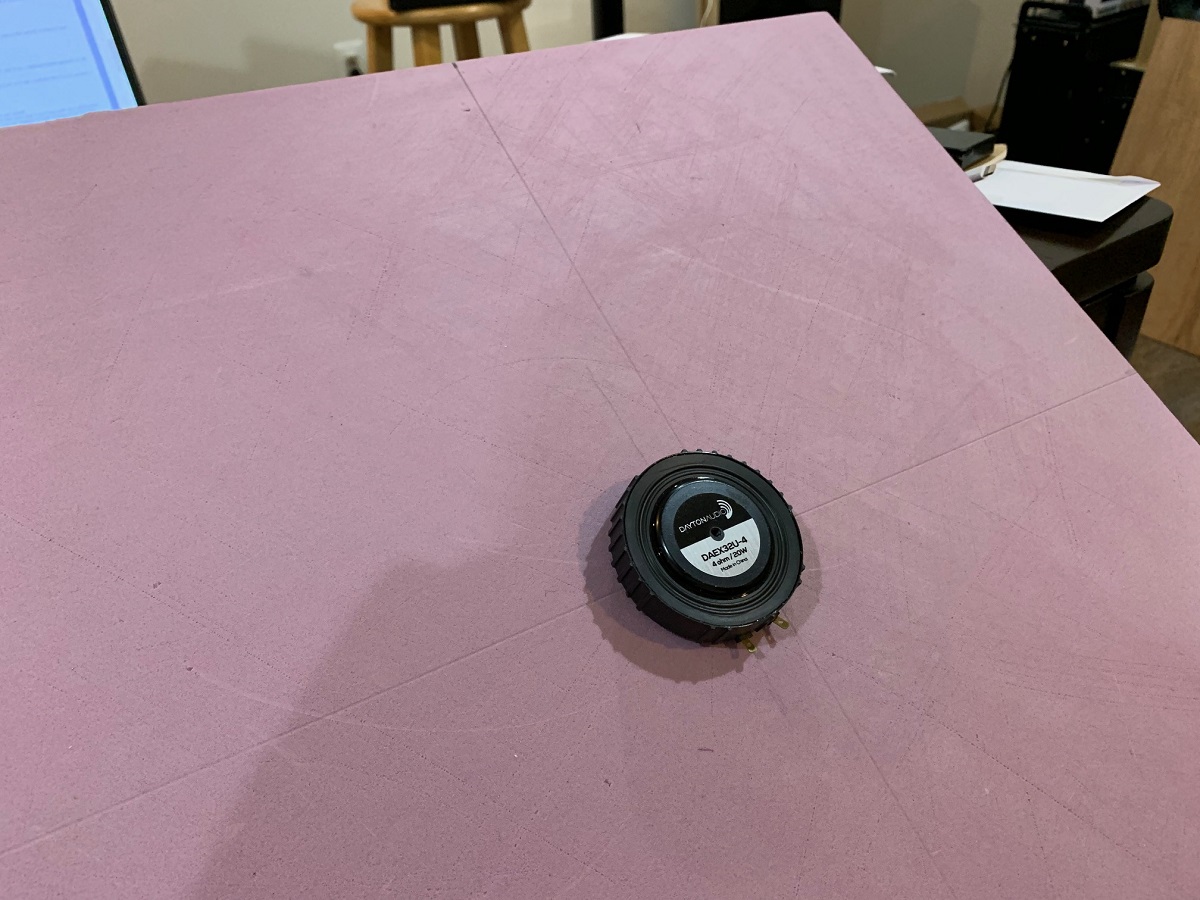
Here is the right panel from the front - hanging with string from an aluminum crossbar mounted to a speaker stand.
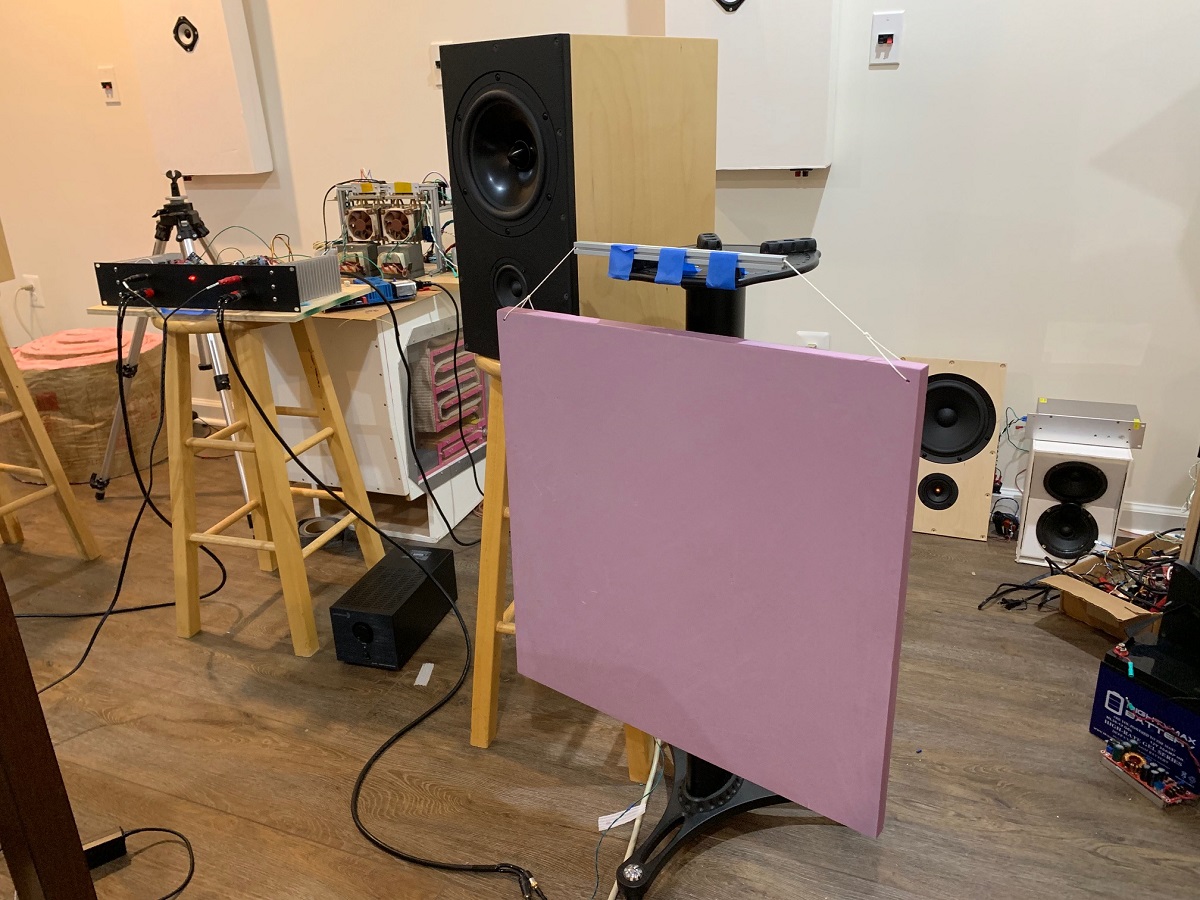
Here is the Tectonic TEAX32C30-4/B exciter mounted on the left channel and detail showing how wires are taped to back to prevent rattle and distortion.

Here is the left channel from the front.

Will do more listening for longer term and report back later. Also will take some measurements later.
Listening to jazz with Chick Correa, Dave Brubeck, Melody Gardot; also some pop and classic rock thrown in. With the EQ, much better and could be really good with a sub woofer.
Applying PVA water mixture. I used a hair dryer to speed up drying.
Dayton DAEX32U-4 (good one) mounted at 2/5 (10in) and 3/5 (14.4in) from edge for 24in x 24in panel. I used soft 28ga wire taped to the panel to bring the leads from the exciter to my amin banana plug speaker cables using female bullet connectors.
Here is the right panel from the front - hanging with string from an aluminum crossbar mounted to a speaker stand.
Here is the Tectonic TEAX32C30-4/B exciter mounted on the left channel and detail showing how wires are taped to back to prevent rattle and distortion.
Here is the left channel from the front.
Will do more listening for longer term and report back later. Also will take some measurements later.
Attachments
Last edited:
I see you have some interesting reference designs scattered about!
You might gain some benefit from rounding the corners as this is believed to increase the mode density which is a good thing. I used a dinner plate as a cutting guide- very scientific!
The brightness has been reported by other XPS users who also eq the response flat. I use ply which gives a flattish response but isn’t so loud. It’s still plenty loud enough with a sub woofer. Personally I think subs are essential with DMLs.
You may find with further listening you get used to the soundstage. I get good localisation and a very wide and deep soundstage but it’s all subjective to a large degree and my references are ESL’s and OB speakers so it might be my conditioning showing.
Good luck with the experiment!
You might gain some benefit from rounding the corners as this is believed to increase the mode density which is a good thing. I used a dinner plate as a cutting guide- very scientific!
The brightness has been reported by other XPS users who also eq the response flat. I use ply which gives a flattish response but isn’t so loud. It’s still plenty loud enough with a sub woofer. Personally I think subs are essential with DMLs.
You may find with further listening you get used to the soundstage. I get good localisation and a very wide and deep soundstage but it’s all subjective to a large degree and my references are ESL’s and OB speakers so it might be my conditioning showing.
Good luck with the experiment!
I see you have some interesting reference designs scattered about!
You might gain some benefit from rounding the corners as this is believed to increase the mode density which is a good thing. I used a dinner plate as a cutting guide- very scientific!
The brightness has been reported by other XPS users who also eq the response flat. I use ply which gives a flattish response but isn’t so loud. It’s still plenty loud enough with a sub woofer. Personally I think subs are essential with DMLs.
You may find with further listening you get used to the soundstage. I get good localisation and a very wide and deep soundstage but it’s all subjective to a large degree and my references are ESL’s and OB speakers so it might be my conditioning showing.
Good luck with the experiment!
You had (have?) two configs? I'm more interested in the London or UK setup and how you think that compares to the French setup. having the panels near to a wall and reaping most of the benefits would be ideal.
I have a pair of Dayton FHE 25s looking for an application. Currently thinking about 6'x2' vertical panels with a slight bow. Ha, should it bow outwards at the top/bottom or inwards?
I built a simple DML using square 1in thick 24x24in XPS panels. I sanded the surfaces with 100 grit sandpaper. I treated one of them with 30:70 PVA:water and was going to see if I could measure any differences between treated and untreated. Tapping them with my hand and listening to the sound and resonance, I cold not hear the difference it made. I ended up suspending them from string onto an aluminum crossbar that allowed them to be suspended from a 30in tall speaker stand. After installing the stereo pair I was disappointed to find out that the left channel exciter went dead upon using it for 1 minute. A check with an ohm meter showed open circuit (pretty dissappointing quality control on the Dayton DAEX32U-4 driver). Really wanting to hear stereo - I removed the bad Dayton and installed a Tectonic TEAX32C30-4/B driver. Different exciters on left and right channel I know but this will have to do until I get a replacement Dayton. The sensitivity sounds about the same with both so not too far off. Listening to it, definitely sounded way too bright - and unbalanced - like it needed a BSC shelf. So I went in Jriver DSP and added a -6dB Q=0.5 high shelf at 1kHz for the BSC. I also added +3dB Q=0.6 200Hz low shelf to boost some bass back. Sound is much more balanced now. Driving with VHEX+ 100w Class AB driven by AK4490 DAC from my Cayin N3 via USB 3.0 from PC laptop running Jriver flac or wav files. The sound is surprisingly good considering how simple and inexpensive the speakers are. The sound is wide and lacks pinpoint imaging. But for most music, it works. I am not wowed by it though. Maybe using identical exciters on left and right might make a difference - we will see.
Listening to jazz with Chick Correa, Dave Brubeck, Melody Gardot; also some pop and classic rock thrown in. With the EQ, much better and could be really good with a sub woofer.
Applying PVA water mixture. I used a hair dryer to speed up drying.
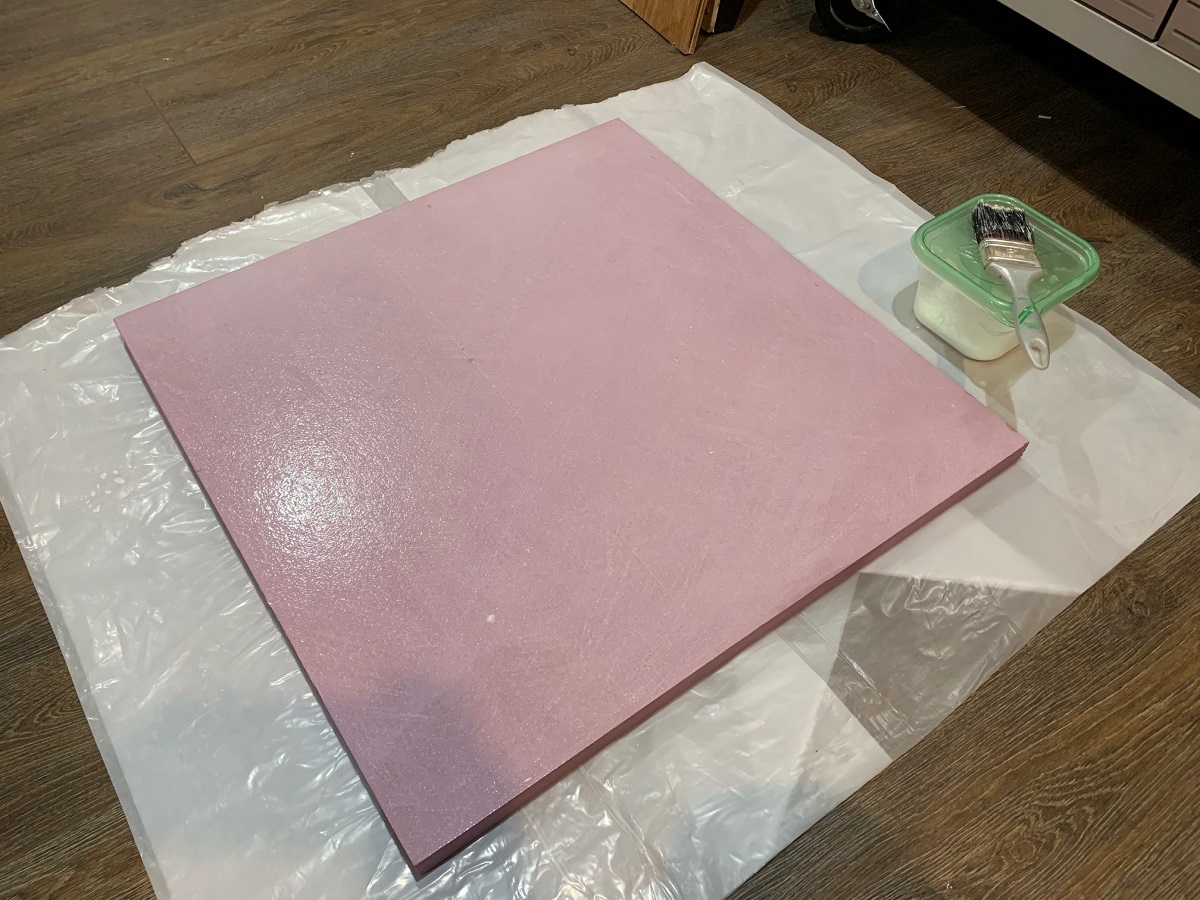
Dayton DAEX32U-4 (good one) mounted at 2/5 (10in) and 3/5 (14.4in) from edge for 24in x 24in panel. I used soft 28ga wire taped to the panel to bring the leads from the exciter to my amin banana plug speaker cables using female bullet connectors.
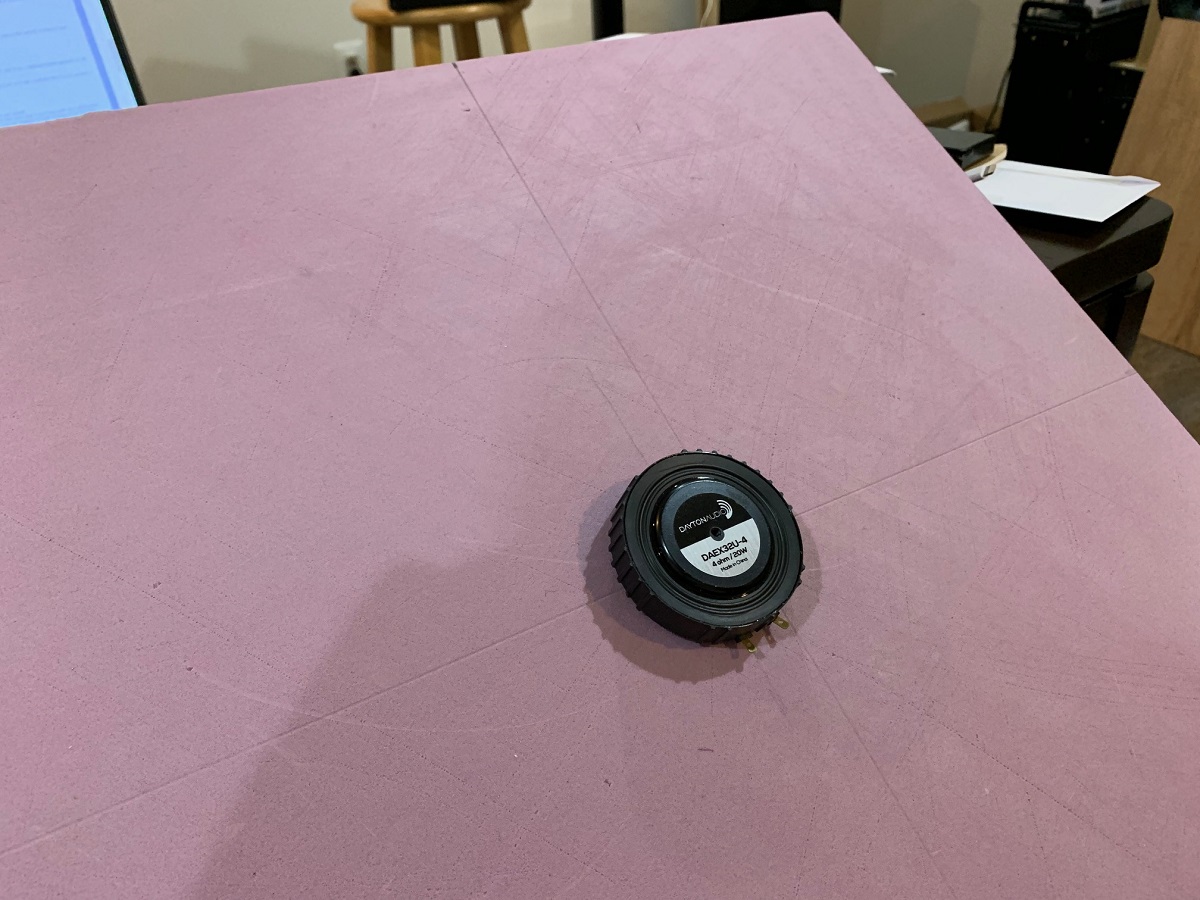
Here is the right panel from the front - hanging with string from an aluminum crossbar mounted to a speaker stand.
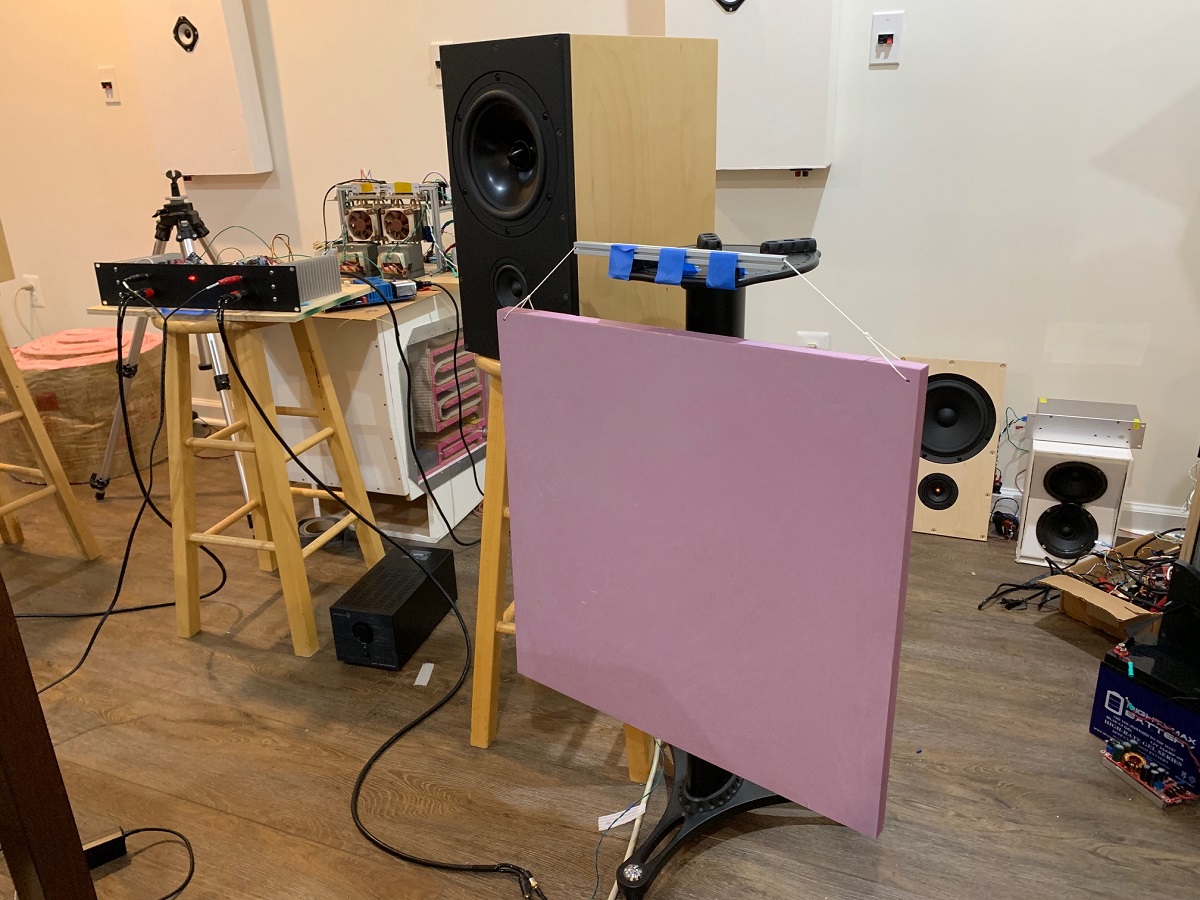
Here is the Tectonic TEAX32C30-4/B exciter mounted on the left channel and detail showing how wires are taped to back to prevent rattle and distortion.
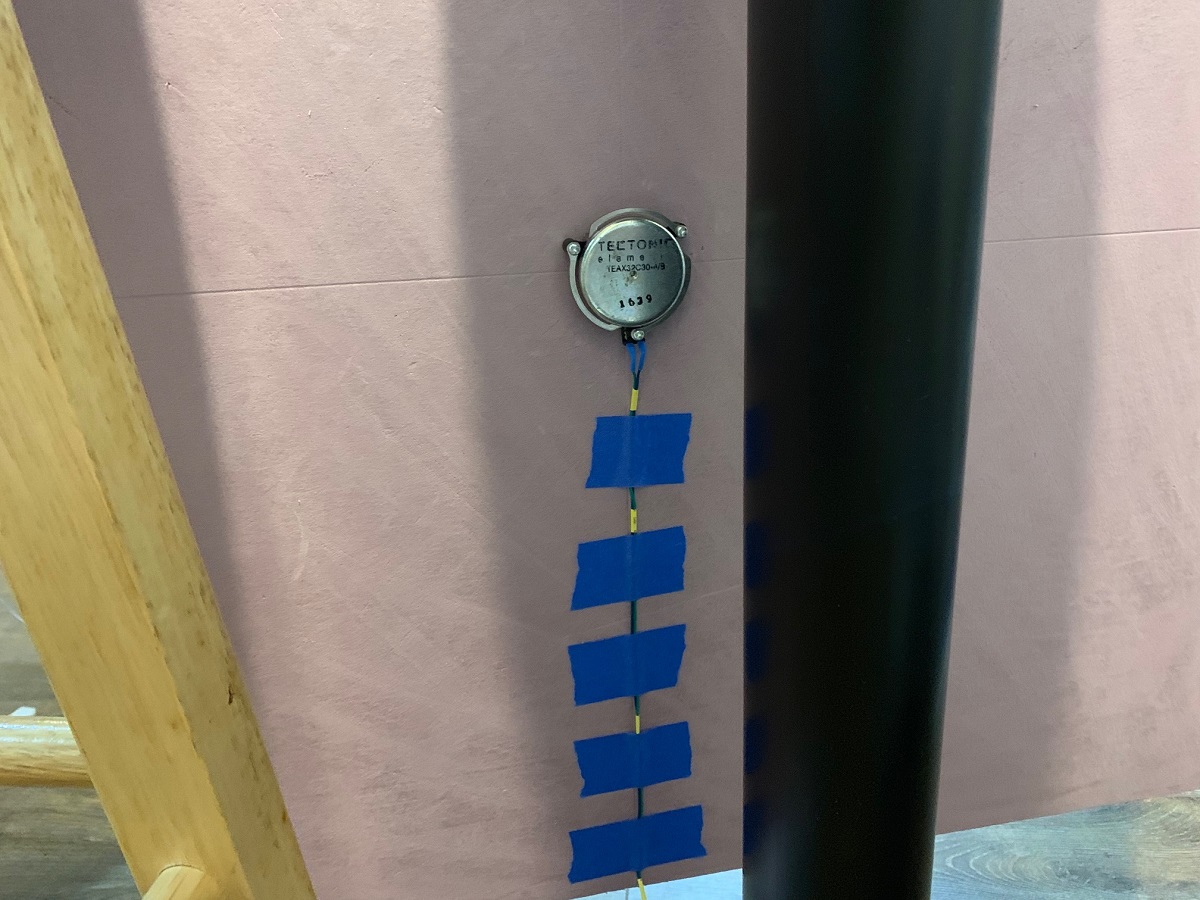
Here is the left channel from the front.
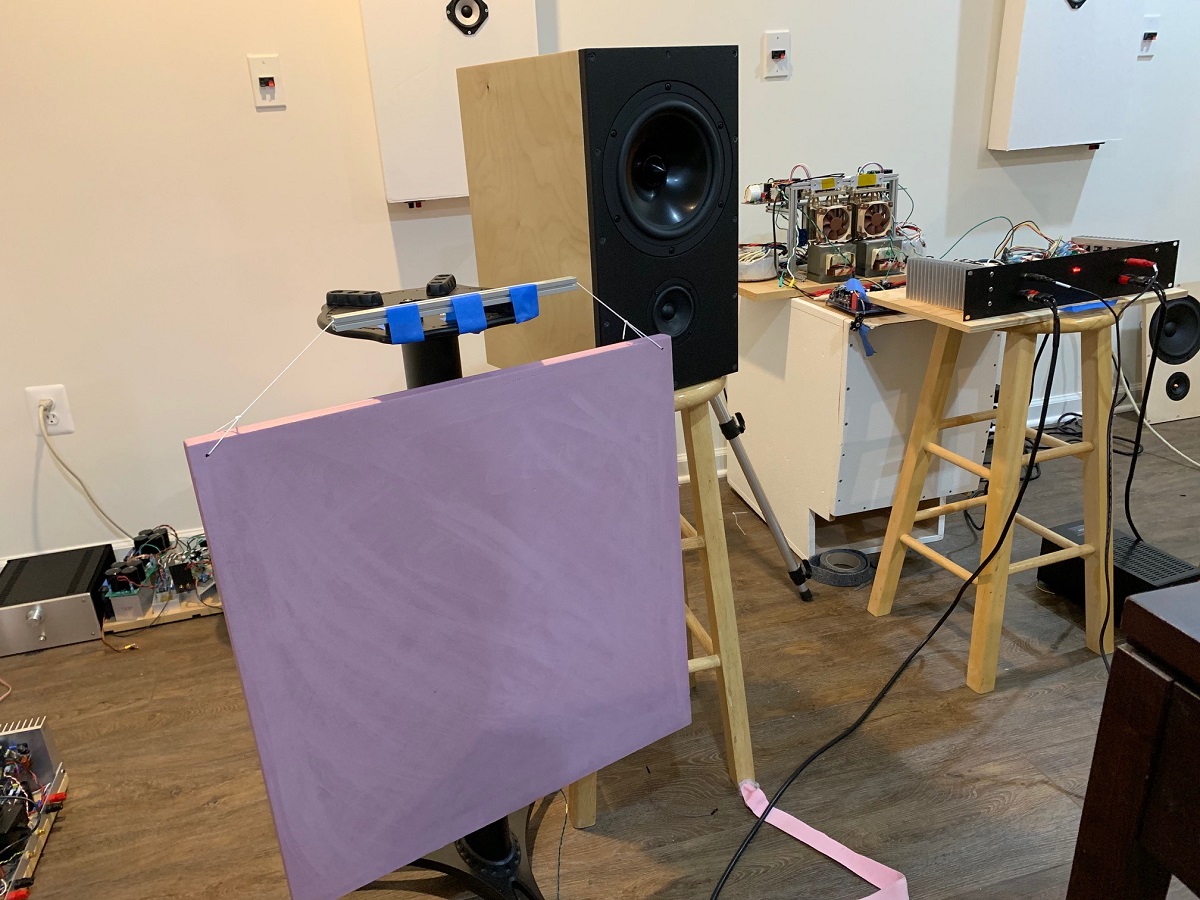
Will do more listening for longer term and report back later. Also will take some measurements later.
Pg.60 post #592 I mentioned that the Ultra exciter is good sounding but has reliability issues. The same way conventional cone speakers need to use the exact same pair exciters need to be the same as different exciters sound different and it does make a difference.
Tape and wire should not be adhered to panel. Instead adhere it to the stand.
Do you have any damping material? If so put them all around the 1inch edges. This technique works for those not using a frame but this technique can also be used with a frame.
I took out my Fluance bookshelf/surround speakers that are 6inch wide by 10 inch height and they sounded pretty good. I was bored so I whipped up some DML panels the same size as the Fluance speakers using the very small 13mm 8ohm Dayton exciters which took about 20 minutes build free floating without a frame but with frost king damping all round the edges of panels and except for the bass the DML panels have much clearer detailed vocals and sound then the Fluance speakers. Although I didn't take any measurements these small panels most likely don't play frequencies below 200hz since they are only 6inch wide by 10inch height. The fluence speakers can reach down to 70hz but IMO at very low spl's its more like 100hz.
My DML sub amp can only go as high as 150hz so its not high enough for such small panels although they do sound pretty good with the DML sub set at its max at 150hz. My DML sub blends better with the fluence only because the Fluance can reach 100hz. If I can make the panels go as low as 150hz it will blend better but this was just the spur of the moment fun experiment.
My DML sub amp can only go as high as 150hz so its not high enough for such small panels although they do sound pretty good with the DML sub set at its max at 150hz. My DML sub blends better with the fluence only because the Fluance can reach 100hz. If I can make the panels go as low as 150hz it will blend better but this was just the spur of the moment fun experiment.
Maybe small DMLs can be used analogous to a full range with a conventional woofer crossed at 600Hz like a FAST? I agree that the mids and highs can sound very good.
So some things to try next:
1. Round corners
2. Use same exciters
3. Add damping on edges
4. Move wiring to stand
5. Cut to rectangle shape
So some things to try next:
1. Round corners
2. Use same exciters
3. Add damping on edges
4. Move wiring to stand
5. Cut to rectangle shape
Maybe small DMLs can be used analogous to a full range with a conventional woofer crossed at 600Hz like a FAST? I agree that the mids and highs can sound very good.
So some things to try next:
1. Round corners
2. Use same exciters
3. Add damping on edges
4. Move wiring to stand
5. Cut to rectangle shape
How about for step 5...say cut 1/2 to 1" off one side to make a slight rectangle. Then measure.
Then step 6, cut from the top left corner to 1/2" below the top rght corner. That gves you a trapezoid. Then test again.
Then step 7, cut from the bottom right corner to 1/2" inside of the top right corner That gives you a trapezium. Test again.
Then step 8, round all 4 corners...and test again.
Oh and make sure to make panels mirror images...
By that time you will have a slightly funky looking almost rectangle with rounded corners with complete asymetry of all angles. Now of course you could make the cuts bigger, say from 1/2" to 1" to 2 or 3" to make it even more apparent of the angular shapes, but then you may be making the panel too much smaller...isn't experimenting fun 🙂
A couple questions for you engineers out there.
1. Can someone explain how to find the fundemental resonant frequency of a panel (either via an equation or by a simple measurement technique).
2. Does the fundemental resonant freq of a panel change in a linear way with the panels size? For instance, if I have a 10" x 20" rectangular panel with a fundemental resonant frquency of 100 Hz. If I then double the dimensions to 20" x 40" does that halve the fundemental resonant freq of the bigger panel to 50 Hz? (all other panel factors being equal)
1. Can someone explain how to find the fundemental resonant frequency of a panel (either via an equation or by a simple measurement technique).
2. Does the fundemental resonant freq of a panel change in a linear way with the panels size? For instance, if I have a 10" x 20" rectangular panel with a fundemental resonant frquency of 100 Hz. If I then double the dimensions to 20" x 40" does that halve the fundemental resonant freq of the bigger panel to 50 Hz? (all other panel factors being equal)
- Home
- Loudspeakers
- Full Range
- A Study of DMLs as a Full Range Speaker

